Get Out!
Do you have a plan? Some situations require immediate action. There is no time to think of solutions or evaluate options. There is only time to act. In the absence of a plan, you are relying on luck and caprice, and that’s a bad situation to be in! Especially if lives are at stake.
This article will explore the basic principles that you need to adhere to, when thinking about evacuation, retreat and emergency escape. Or, if the best course of action is to buckle down and ride the storm out.
The Physical Reality
First of all, you need to be realistic in terms of what you are physically capable of. An example of this would be if you lived in a double story house and your evacuation route entails running up two flights of stairs, then climbing into the attic, and then zip-lining into the forest.
The physical aspect of this should not be underestimated. Number one, will your knees, quads and cardio take you up the stairs at such a rate that an attacker will not be able to catch up to you? Second, how long would it take to prep yourself for the zip-line? Third, can your hands bear the entire weight of your body for the duration of your slide, and then how well can you handle coming in for a high speed running landing.
Your escape plan needs to be brutally honest about the physical ability of the individuals who need to implement it. It makes little sense to plan a route where you need to climb over a wall or fence, if you cannot do a single pull-up. In the short term, plan around what you are capable of.
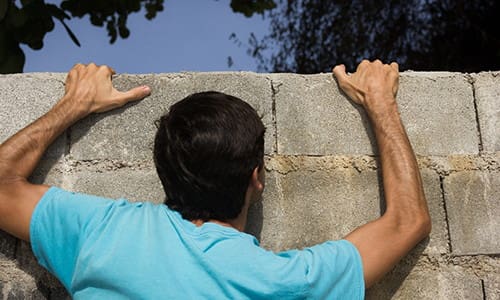
Sizes And Heights
The ideal escape route takes you out of your house through a door at a brisk walk. There may however be circumstances when you want or need to exit through a window or crawlspace. Don’t assume that you will fit through a given opening. Always put it to the test.
Secondly, windows have a higher ground clearance on the outside than on the inside. If you can easily reach a window to climb through when you are inside the house or building, there is a high probability that your legs will be too short to reach the ground on the outside. Be prepared for this. The best way to deal with this, is to sit with your behind flat on the window sill, legs dangling down, and then push off with your hands. Jumping from a crouched position is not ideal.
I have moved at speed through a variety of openings throughout my career, and I will offer three short pieces of advice when going through air vents, bathroom windows or ventilation hatches, including manholes or crawlspace hatches.
Watch out for belt buckles or belt loops on pants, as they might catch onto handles or lock pins. The same applies to shoelaces. The same applies to jewelry, including watches and rings. I put any rings I wear in my pocket when I start climbing or moving in confined spaces. Especially when using a ladder. If your ring catches when you jump or slide, it can cut your finger or cause other injuries.

Protection And Assistance
When exiting through a window, place a cushion, blanket or folded towel onto the surface you will be crawling across. The additional protection will reduce the risk of injury while increasing the speed at which you are moving. The protection offered to the shins and knees in particular can be a great help.
Secondly, chairs, footstools, or small ladders will be a great help. If you have a specific room or area through which you are planning an escape route, place a small foldable ladder behind the door or a chair in proximity to the window or area you wish to access.
The Art Of ZEN
The way of water.
Water always follows the path of least resistance. It also flows effortlessly around obstacles in its way. This is a worthwhile way of thinking about moving out of your confines toward safety. This is also the optimal way of planning your route through a house, or apartment building.
There is also a phrase that originated from the Navy Seals and is often quoted in martial arts that expresses a truism for these types of circumstances: “slow is smooth, and smooth is fast”. This may seem counter-intuitive, but imagine a scenario where you are exiting your house.
- In this one scenario, you are running to see where the kids are, then you start looking for the keys for the truck, next you start to wonder where your mobile phone is. You send the kids outside to wait at the truck, but one of them goes looking for the cat. You find the phone but now wonder where your purse is, etc.
Versus.
- You walk into the playroom, gather the kids and walk out of the house. You have your old phone in the glove compartment of your truck and a spare set of keys hidden in a lock-box on the back of the truck. You have spare cash in the truck, along with a few snacks, etc.
Slow is smooth and smooth is fast.
Related: How to Prepare Your Homestead In Case Of a Natural Disaster
Keys And Access
Invest in the types of locks that require keys on the outside but are lever operated from the inside. You don’t want to get trapped inside your house by a locked door. Alternatively, hang a key on a hook at each door. Remember that when you are panicking, a bunch of keys on a key ring can be just as useless as no key at all.
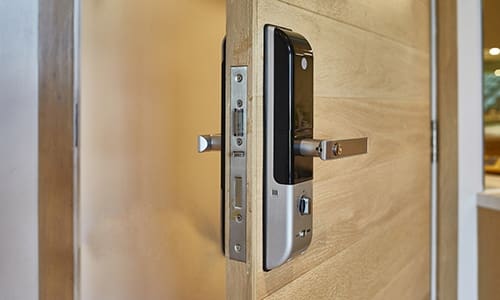
Impending Danger
It’s important to know where people are. This is extremely important in times when you suspect that things could go wrong. Loud music or earphones could cost your life in the event of an attack or other danger.
Go Bags
These are best placed next to exits. If they are in an area of the house that is not along the escape route, chances are you will not be able to get to it.
Escaping A Room
I have a fire-extinguisher and Stanley Fubar in every room. I keep the Fubar under the bed. You get smaller versions of demolition and pry-bars. These should be standard equipment for emergencies of almost any kind.
Also, in almost every emergency the power will be out. Fire, water and wind usually affect the grid or home electricity. Your emergency escape route must be safe to navigate in the dark. But, you must always have a flashlight ready.
Escape routes should always be clear of electrical cords, animal food and water bowls, and other obstacles like school backpacks etc.

Time, Distance And Bottle Necks
A human moving fast can easily cover 5 yards per second. This means that in the average house, there is no point that is more than 5 – 10 seconds away. This is good news because it means that you can get out real fast. But it’s bad news when you have attackers in the house.
You can get to the door in 5 seconds, but if you take 5 seconds to open a door, then you will be caught.
Another aspect to keep in mind is that if you are exiting through a window or other restricted opening, that the time spend maneuvering through, will be more than you think. This makes it unsuitable for instances in which you are running from attackers, unless you can bolt a door behind you to buy some time.
The sequence of people during an evacuation should be adults and strong and fit individuals in front and at the rear, everyone else in between. Even when moving through a window, an adult must go first, to assist with those coming after.
Kitchens
If your kitchen has a gas stove or a refrigerator, it would best to avoid it in the case of a fire. Refrigerators explode amidst fire, and the dangers from the gas line being compromised are obvious.
But be sensible about this, if there is no fire close to the kitchen, it will be safe. But, if the kitchen is already on fire, stay clear.
Shields
I don’t personally own any, but there are remarkably good shields available for purchase these days. Many are bulletproof, but will also shield you from heat or falling debris in the case of a fire or even severe storm. If you are serious about confronting any kind of challenge, these are great options and versatile.
Related: The Best DIY Traps Against Property Intruders
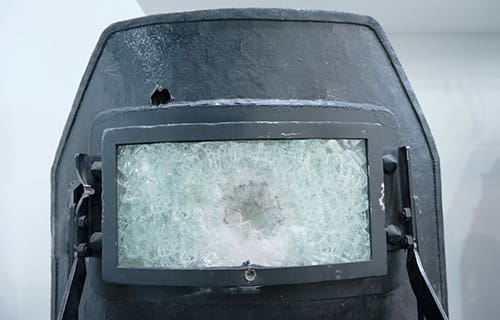
Crawling On Hands And Knees
This may be the hardest thing to do, but could save your life. Heat and smoke rise to the top of a room. If you doubt whether you can cover the distance upright, consider going down. You will immediately notice the difference. Now re-evaluate your situation and go for the exit if possible.
Diagram
A hand drawn diagram should be enough to get you thinking about the best and fastest route. Always include primary and secondary routes in the diagram. Primary routes go for doors, while secondary routes are just to get you outside.
I would do a plan for an attack and a fire. They will look similar and overlap, but both will get you thinking and that is the most important thing.
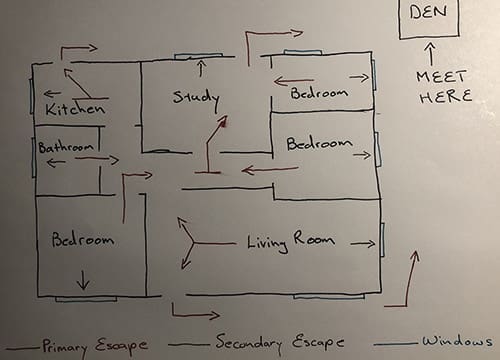
So there you go folks, the do’s and don’ts of escaping houses and buildings. Best to be prepared before hand.
You may also like:
 15 Things You Should Teach Your Children That Can Save Their Lives
15 Things You Should Teach Your Children That Can Save Their Lives
The Bunker Food You Need To Have Right Now (Video)
Best Dog Breeds For Homesteaders
6 Best Guns To Have Around Your Homestead
How To Make A Pressure Sensor Pad To Know When You Have An Intruder On Your Property
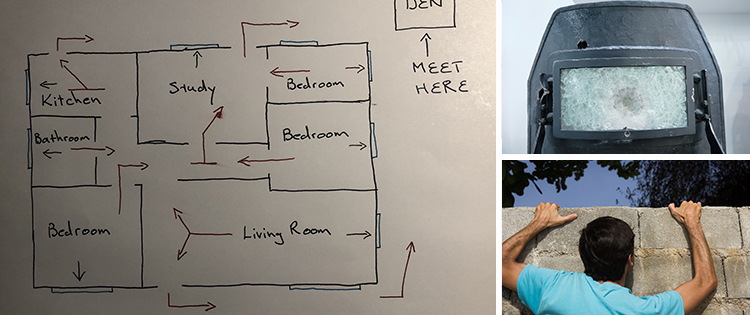








I have seen recommendations before about escape plans, usually targeted at fires (this is also part of Cub Scout advancements for most ages). But what no one really explains is young children + two story house. Yes, their bedrooms have windows. And I’ve seen the escape ladders than hang from the windows. But often they can not slide the window up (we have older windows). And then even if they could, then there’s the screen or storm window to deal with (depending on the time of year).
Any suggestions?
Hi Marie,
I have spent some time just thinking this over.
In the instance mentioned, I would put the storm screen on hinges and secure it with a sliding bolt, that can be opened from inside without a lock or complications. The screen can then be swung open.
The window will need to be replaced or modified in such a way that the kid can open it. Either by running a rope from the top of the window through a roller mounted to the roof and then weighted. Old sliding windows had a similar internal system, but the weight is such that it’s too little to open the window on its own, but a little effort will raise it. It will however then be harder to close…
But additionally…
The first point I think is as mentioned at the beginning of the article, that your escape plan must take into consideration your physical abilities. I used the example of climbing stairs and then using zipline, but the same could apply to a steel escape hatch or manhole cover that is too heavy to move.
When it comes to kids, you have a few extra issues, apart from the physical strength part.
It would also really depend on the age of the child. In kids, 2 years is a long time. A four-year-old has capabilities far beyond a two-year-old, and the same applies if you think of 8 to 10.
Firstly, and we see it in nature all the time, is that the young need adult care and protection until they are able to take on the role of their own protection. This requires physical, but also emotional strength. You will need to work on a plan or system that is not only within their physical ability but also their emotional and intellectual ability.
Secondly, I would really recommend that a parent’s escape plan revolves around getting to the children to ensure they are safe. At night, if anything goes wrong, parents have to take their children and then move on.
Secondly, you could encourage the older sibling to help the younger sibling, and maybe find a way where both push the window or screen together, but the issue is when they are alone
If you have the finance, see about putting a door between the two rooms, like hotel rooms, that can only be opened from both sides. Two will always be better than one. And maybe do the same between parents and children room.
In South Africa, a few families have perished in house fires because they could not exit through the burglar bars. Prompting some companies to build fire-retardant doors etc.
Some people have opted for changing burglar bars into something that works like a door. This relates to the above-mentioned storm screen which is mounted on hinges.